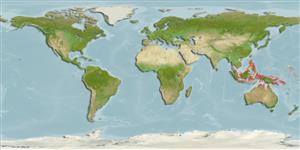>
Gobiiformes (Gobies) >
Gobiidae (Gobies) > Gobionellinae
Etymology: Pandaka: Sanskrit, pandaka = without testicles, hermaphrodite, homosexual; it is a Philippines fish, the smallest of the world.
More on author: Herre.
Environment: milieu / climate zone / depth range / distribution range
Ökologie
seewasser; süßwasser; brackwasser demersal; pH range: 7.0 - 8.4; dH range: ? - 30; amphidrom (Ref. 46888); tiefenbereich 0 - 2 m (Ref. 90102). Tropical; 24°C - 30°C (Ref. 2060)
Asia: Indonesia and Philippines. Originally reported from the Malabon River, Rizal, Philippines, which has meanwhile been reclaimed. According to Ref. 6216 it has also been collected in the sea at Culion Island, off Palawan, Philippines. Recently collected in Bali (1991), Sulawesi (1988), and Singapore (1992), M. Kottelat, pers. comm.
Length at first maturity / Size / Gewicht / Alter
Maturity: Lm 1.0, range 1 - 1.1 cm
Max length : 1.1 cm SL Männchen/unbestimmt; (Ref. 2060); 1.5 cm TL (female)
Rückenflossenstacheln (insgesamt): 7; Rückenflossenweichstrahlen (insgesamt): 6-7; Afterflossenstacheln 1; Afterflossenweichstrahlen: 6 - 7. Dark spots on sides of body somewhat forming 4 cross-bands; heavy pigmentations on all bases of fins, except ventrals, apparently are continuation of body pigmentation. Head and nape naked. 22 to 25 scales in longitudinal series (Ref. 4924); further characterized by presence of black spot at middle of caudal fin base; first dorsal fin yellowish with black anterior; rounded caudal fin (Ref. 90102).
This is one of the smallest freshwater fishes: males are mature at 9 mm, females at 15 mm. The species used to frequent shady river banks in the Malabon River, Rizal Province, Luzon, Philippines; however, the type locality has been reclaimed and the remaining waters in the area are heavily polluted; the species is considered extinct in the Philippines (Rainer Froese, pers. comm., 2004). It has been apparently imported into Germany in 1958; a color photo of the fish was taken in an aquarium (Ref. 2060). Found in brackish waters and mangrove areas of Indonesia (M. Kottelat, pers. comm.).
Life cycle and mating behavior
Geschlechtsreife | Fortpflanzung | Ablaichen | Eier | Fecundity | Larven
Probably a non-guarder (RF).
Larson, H.K., 2001. A revision of the gobiid fish genus Mugilogobius (Teleostei: Gobioidei), and its systematic placement. Rec. West. Aust. Mus. (Suppl. No. 62):1-233. (Ref. 43716)
IUCN Rote Liste Status (Ref. 130435)
Bedrohung für Menschen
Harmless
Nutzung durch Menschen
Fischereien: nicht kommerziell
Mehr Information
ReferenzenAquakulturAquakultur ProfilZuchtlinienGenetikElectrophoresesVererbbarkeitKrankheitenVerarbeitungNutrientsMass conversion
Tools
Zusatzinformationen
Download XML
Internet Quellen
Estimates based on models
Preferred temperature (Ref.
123201): 27.6 - 29.2, mean 28.8 °C (based on 873 cells).
Phylogenetic diversity index (Ref.
82804): PD
50 = 0.5078 [Uniqueness, from 0.5 = low to 2.0 = high].
Bayesian length-weight: a=0.00977 (0.00442 - 0.02163), b=3.05 (2.86 - 3.24), in cm total length, based on LWR estimates for this (Sub)family-body shape (Ref.
93245).
Trophic level (Ref.
69278): 2.9 ±0.4 se; based on size and trophs of closest relatives
Widerstandsfähigkeit (Ref.
120179): hoch, Verdopplung der Population dauert weniger als 15 Monate. (Preliminary K or Fecundity.).
Fishing Vulnerability (Ref.
59153): Low vulnerability (10 of 100).
